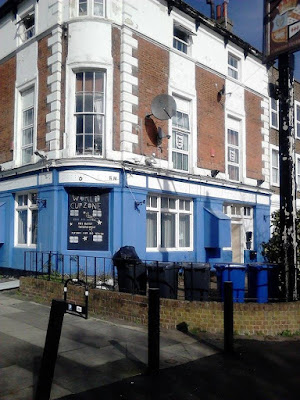I never tire of the way that a chance picture of some one long dead sets off a story which goes off in a dozen different directions.
And so, it was yesterday when Tony sent over his photograph of one of the gravestones in Southern Cemetery with the comment, “knowing your interest in the Red Cross I thought you might find this interesting”, which of course I did.
The grave belongs to Miss Lydia William Falconar Grant, who died on April 1st, 1917 at the Ducie Avenue Military Hospital.
The inscription reads “Lydia William Falconar Grant V.A.D. Member of the Red Cross Society of Australia, born at Falcon Hall, Morningside, Edinburgh and died at Ducie Avenue Military Hospital, Manchester, on the 1st of April 1917, Elder daughter of Peter G. Grant & Emily Grant of Brisbane, Queensland”.
She was born in Scotland in 1880, grew up in Australia, served at a military hospital just off Oxford Road, in Manchester, and died just a year after she was engaged by the Red Cross as a member of the Voluntary Aid Detachment.
This was a voluntary unit of civilians providing nursing care for servicemen in the UK and across the British Empire.
And this was the start of the story.
Falcon Hall was a very large 18th century mansion in Edinburgh, which according to one source belonged to the family. Her father described himself as a “land surveyor”, and after returning to Australia in late 1880 he appears to have become a police magistrate.
Miss. Grant was educated at the Ladies’ Methodist College in Melbourne, and was living in Brisbane when she volunteered to serve with the Voluntary Aid Detachment.
She left Australia in September 1916, and after four days in London was posted to Manchester, beginning work in December of that year.
According to one press report she felt the intense cold weather in Manchester but “she was always very happy, and keenly interested in her work. Her letters showed also that she had met with great kindness from those with whom she came into contact, and found both in sisters and nurses engaged in the same hospital much congenial comradeship”.*
The hospital was the former Ducie Avenue Municipal school, which had been requisitioned in 1916, and consisted of 240 beds, of which 88 were specialists’ ones, and until 1917 it had an orthopedic section.
Sadly, she contracted measles in the late March of 1917, which developed into Septic Arthritis on March 28th, and by the following day she “became unconscious with very little hope of recovery”.
Her funeral was reported in The Searchlight, which was the monthly publication of Second Western General Hospital in May, reporting that
"Miss. Grant was one of the first contingent of the Australian Probationer who came to us last November and during her short period of work here and also during her illness, bravely and patiently borne had greatly endeared herself to all she came into contact.She was laid to rest in Southern Cemetery on April 4th, close to the grave of V.A.D., Nursing Member Pearce, whom we buried only a few weeks ago. At the request of friends, the funeral was a private one, and the service, which was very impressive, was conducted by the Ven. Archdeacon Aspinall, assisted by Cap, Worseley.
It was attended by Sargt. C Grant, 1st Australian Division, Capt. Brentnall, R.A.M.C. (T.F.) and a large number of Sisters and nurses of the Second Western General Hospital staff, including seven other members of the Australian contingent”.
I doubt I will ever get to see the letters she wrote home, and so have no way of knowing what she thought of Manchester, but I hope on her days off she got to see something of the city.
There will be more that will come to light about Miss Grant.
For now, we have a photograph, an entry in the book commemorating the work of the 2nd Western General Hospital,*** her Red Cross record card and a handful of other sources.
And I have to thank Bruce Terrell who is a relative and first alerted me to the photograph of Miss. Grant and to Bruce Anderson who gave me permission to reproduce pictures of the Ducie Avenue Military Hospital from his excellent web site, Rusholme & Victoria Park Archive****, and went off and did his own research and coming back with many of the other sources I used, from the Cairns Family History.
Leaving me just to thank Tony Goulding who sent me the picture of the grave and set me on the story.
Location; Scotland, Australia, Manchester
Pictures; gravestone of Miss Lydia William Falconar Grant, 2020, from the collection of Tony Goulding, cover 2nd Western General Hospital, 1919, courtesy of David Harrop, photograph of Miss. Grant, Women in war, ANZAC Centenary Queensland, 2014-2018, https://anzac100.initiatives.qld.gov.au/remember/women-in-war/index.aspx, Ducie Avenue Military Hospital, 1916-1919, courtesy of Rusholme & Victoria Park Archive, https://rusholmearchive.org/rusholme-military-hospitals-1914-1918
* Cairns Family History, https://cdfhs.org/indexes/cairns-wwi-soldiers/grant-lydia-wilhelmina-falconer/
**The Late Miss Lydia Grant, V.A.D., Cairns Post May 16th, 1917
*** 2nd Western General Hospital, Manchester , 1914-1919
**** Ducie Avenue Military Hospital, 2nd Western General Hospital, Rusholme & Victoria Park Archive, https://rusholmearchive.org/rusholme-military-hospitals-1914-1918
***** Cairns Family History, https://cdfhs.org/indexes/cairns-wwi-soldiers/grant-lydia-wilhelmina-falconer/
























.jpeg)

crop.jpeg)


















.jpeg)
.jpeg)


